Birds are typically categorized by their sizes, the color of their feathers, and the length of their wings. But it is rare to find birds being categorized by the length of their beaks. There are so many types of bird beak sizes and shapes. We can even tell what they feed by observing their beak’s size or shape. The bird’s beak can also tell where they live. A bird’s beak is also known as a bill or rostrum.
Although they come in different sizes and shapes, all birds’ beaks have a similar basic design. They have the upper and lower mandibles, which are covered with a keratin layer known as the rhamphotheca. This keratinized layer makes the beak hard and sturdy. In many bird species, there are two nostrils-like openings that are connected to the respiratory framework.
In this post, we will list the birds with long beaks and explain their characteristics, habitats, colors, and so many more.
1. Stork
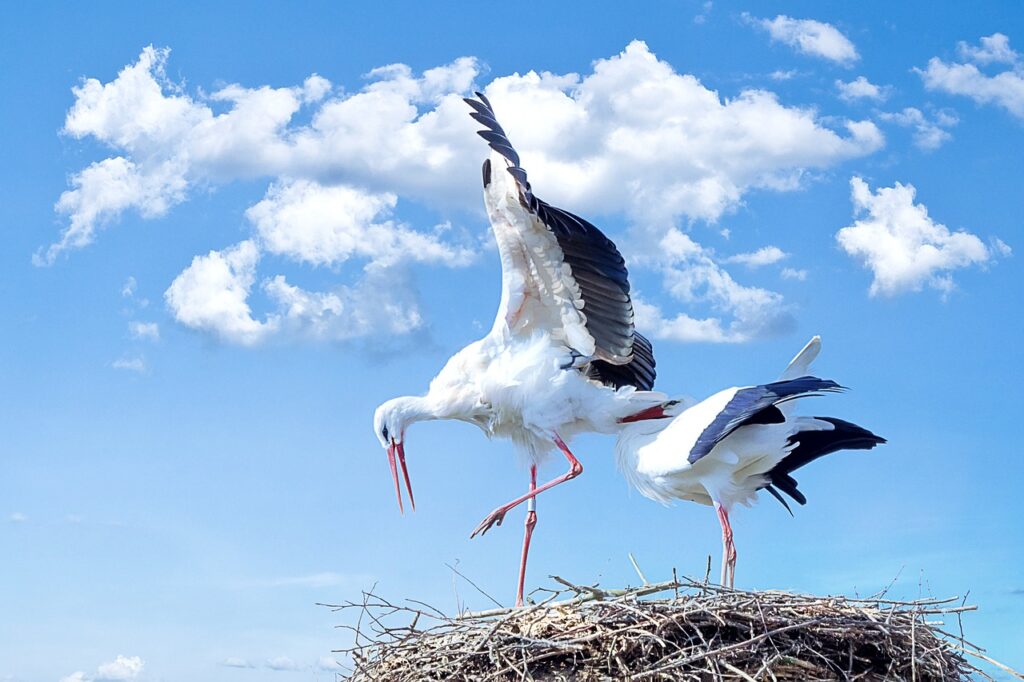
Storks are waterfowl with long beaks, necks, and legs. With these features, they are able to roam waterlogged areas in search of food. Their beaks are 5 to 8 inches long, and they feed on a variety of insects, spiders, scorpions, crustaceans, small mammals, fish, snakes, and lizards.
These birds with long beaks like shallow water areas, and they like to nest in small groups. Storks are found throughout Europe, the Middle East, and northern Africa, and some are found in Asia. When they see prey, they stretch their beaks forward to get it and feed on it. Their nests are often huge and can be used for long periods of time.
Some nests are known to grow more than 2 meters (6 feet) spread and about 3 meters (10 feet) inside and out. In the past, all storks were considered monogamous. However, recent studies show that this is only a part of their lives. Some groups of animals may change partners or move without a partner after they relocate.
2. Toco toucan
Toco Toucan has 7.5 inches of beak length. They are the largest among the toucan species. These birds are originally from South America’s tropical forests. It is known that the natives use these birds as mediums to connect with the dead.
Toco toucans are usually found in semi-open places. The bright orange beaks are useful to reach things that are far from them. They also use the beak to peel fruit skins, scare away the predators, and frighten other birds. The beak can also be used to eliminate their body heat like elephants use their ears. But the birds’ beaks’ ability to reduce their body heat depends on how fast they move or fly. If they fly at a low speed, they can only produce around 25% of body heat reduction, and this is so much lower than the heat they produce. A study showed that the resting heat production of the bill of a duck was 9% lower than that of an elephant’s ears. The bill’s ability is usually responsible for 30 – 60% of heat damage.
The toco toucan has black feathers on its body and white feathers on its throat. They regulate their body temperatures with their beaks by regulating blood flows to their beaks. The birds tuck their beak under their wings while sleeping. They are mostly found in hollow trees that are abandoned by woodpeckers, and they lay around 2 to 4 eggs every year.
3. Flamingo
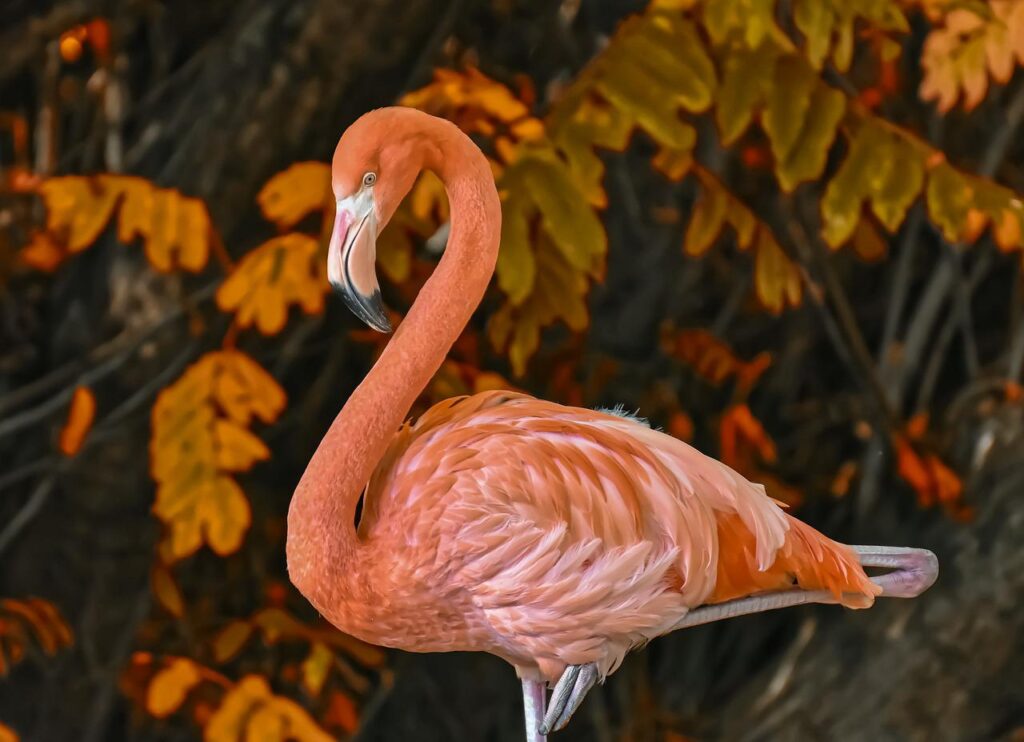
Flamingoes are pink-colored birds with long beaks that are mainly found in Southern Africa, and some are also found in Yemen. These birds live in alkaline environments such as salt lakes, estuaries, and pans throughout Africa.
Flamingo’s beak is curved and acts as a filter to remove mud from their food. The tip of its beak is black, and the beak has a pale orange color towards the base. Flamingoes are beautiful birds, and that makes them unique among bird species. The length of the beak is 5 to 7 inches. These birds are easily affected by their environment, and they are vulnerable to the changes that occur in their environment. They can travel a very long range in a day, up to 280 miles, to find a suitable environment for them.
The birds mostly feed on blue-green algae, but sometimes they eat small insects and crustaceans too. Flamingoes live in large groups, and these birds don’t migrate. These birds are more active at night than during the day.
They love to fly between bodies of water in a stunning V-shaped formation. They use their visual perception a lot because they can’t smell or taste much.
A flamingo pair stays together when they produce their offspring. They stay together in the colony while breeding. The female bird lays one egg at a time. The child will then be provided with “crop milk”, a substance derived from the upper stomach tubes of the parents.
At the age of 6 days, the chick joins with many other small chicks in the colony. They recognize their folks by the sound they make.
4. Dalmatian pelican
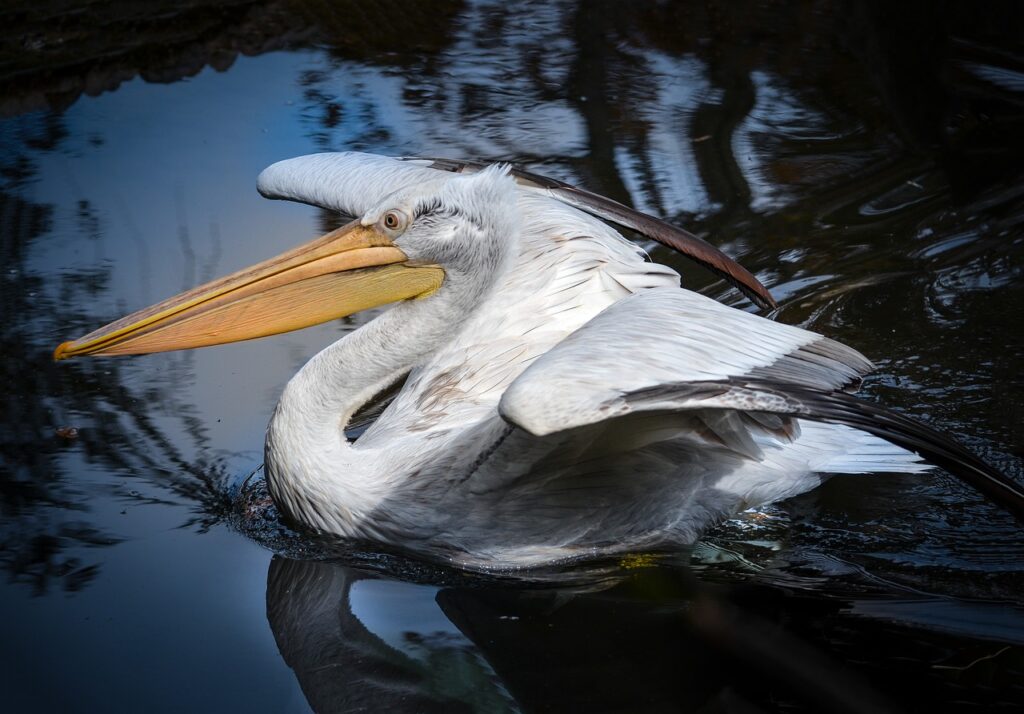
Dalmatian pelicans are the largest of the pelican family. They are one of the largest birds that still exist today. The birds have brilliant feathers in its season, a bright silver color, then fade to a less bright or gray color for the rest of the year.
The length of the beak is 14 to 18 inches. Their beaks are used to scoop food, distribute the oil through the feathers, and groom themselves. Dalmatian pelicans have yellow and purple skin around their eyes. These birds also have a thick silver feather crest around their neck. They also have a red flexible pouch under the beak.
Dalmatian pelicans are one of the biggest and heaviest birds that fly around. These giant birds also can swim well. As social birds, they travel in groups. Their heads are twisted back and tucked into their wings when they sleep.
The dalmatian pelican hunts alone sometimes, but they also hunt in flocks some other times. They mostly eat fish, small reptiles, aquatic crustaceans, and amphibians. The birds can be found in eastern Europe, central Asia, and Russia.
5. Bald eagle
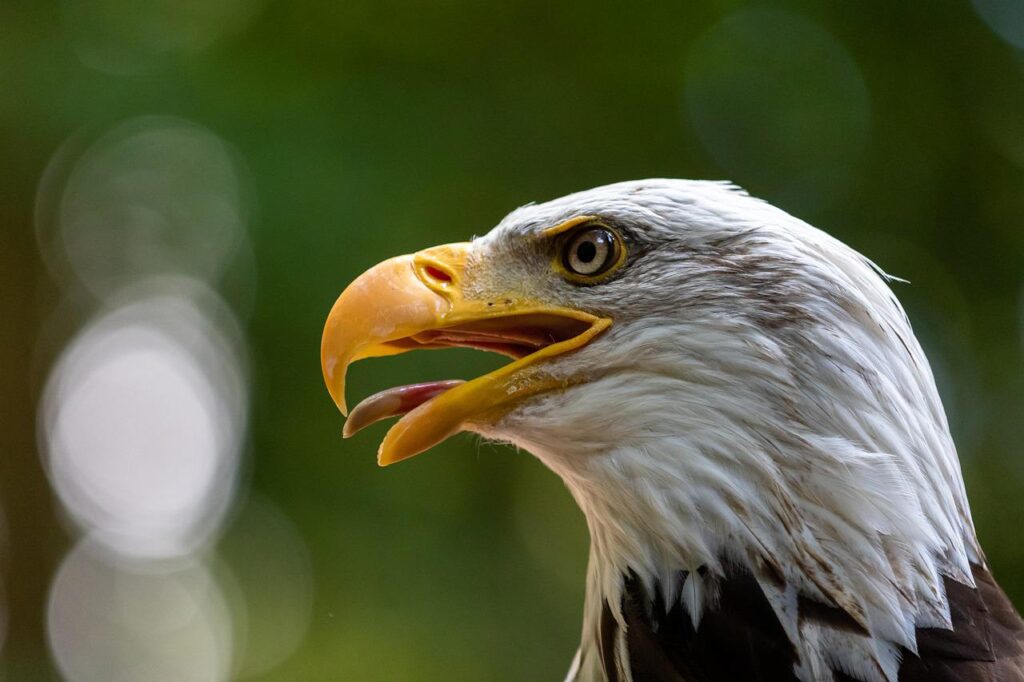
The bald eagle is a symbol of boldness, strength, and opportunity. The bird is an essential symbol that can be found on the USA public seal. They have earthy-colored feathers on their bodies and white on their heads and tails. Their incredible snared bills are yellow, and so are their feet.
When they’re infants, the bald eagles’ feathers are all earthy colored. As they grow up, their colors are more established: the beak turns yellow, and their head and tail turn white. The birds are mostly found close to vast water collections that provide their food supply and trees for nesting.
Bald eagles mainly feed on fish. They will dive in to get a fish and hold it with its claws. The vast water collections have been the most important home to many kinds of North American fowls, and the giant tree as a home for any other creatures was recorded to have 13 ft (4 m) profound, 8.2 ft (2.5 m) width, and one metric ton in weight. Bald eagles are ready for mating at the age of 4 to 5.
6. Long-billed curlew
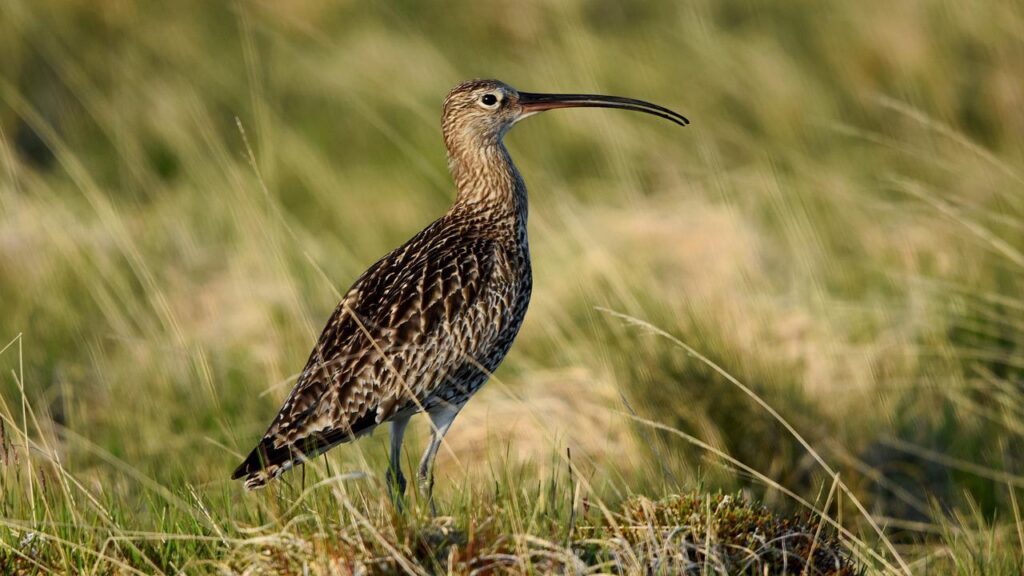
Long-billed curlew is the longest shorebird in America. They have a long beak of 4 to 8 inches in length. These birds that are mostly found in North America feed on insects like beetles, grasshoppers, and crickets. They sometimes also eat amphibians.
The birds have brown speckles on their wings and light heads and chests. They have a very long curved beak. The curlew has been eating herds regularly for some time. They use their long beaks to test the mud or other substances to find good food. Their food is mostly spineless creatures and crabs. Female and male long-billed curlews look alike. The one thing that differs is the size of the beak: the females have longer beaks. Female curlews lay four eggs in their nests that are mostly found near rocks and shrubs.
7. Rhinoceros hornbill
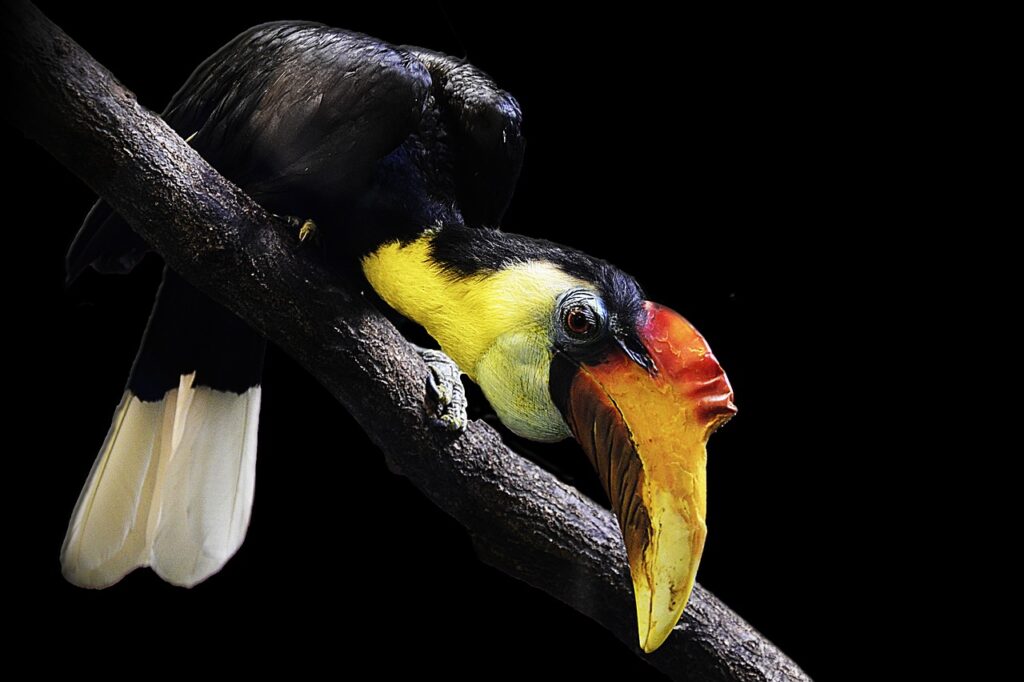
The Rhinoceros Hornbill is a huge but gentle bird that is usually found in Asia’s forests. You can always find them on the top of the tree. They have an incredible beak with a feature on the tip that is called a casque. It was named casque because of its upward curved shape that resembles a rhino horn.
The length of the rhinoceros hornbill’s beak is somewhere between 9.2 and 12 inches. The bird uses the beak to reach food such as fruits hanging on thin branches. They use the casque of the beak as an echoing chamber to make loud noises.
The males and females look similar: they both have white tails and large wings. While the males have red or orange rings around their eyes, the females have white ones.
The birds are native to Indonesia. They like to eat fruits, bird eggs, lizards, tree frogs, and arthropods.
The females usually stay in their nests while the males pass the food through a small hole.
8. Collared aracari
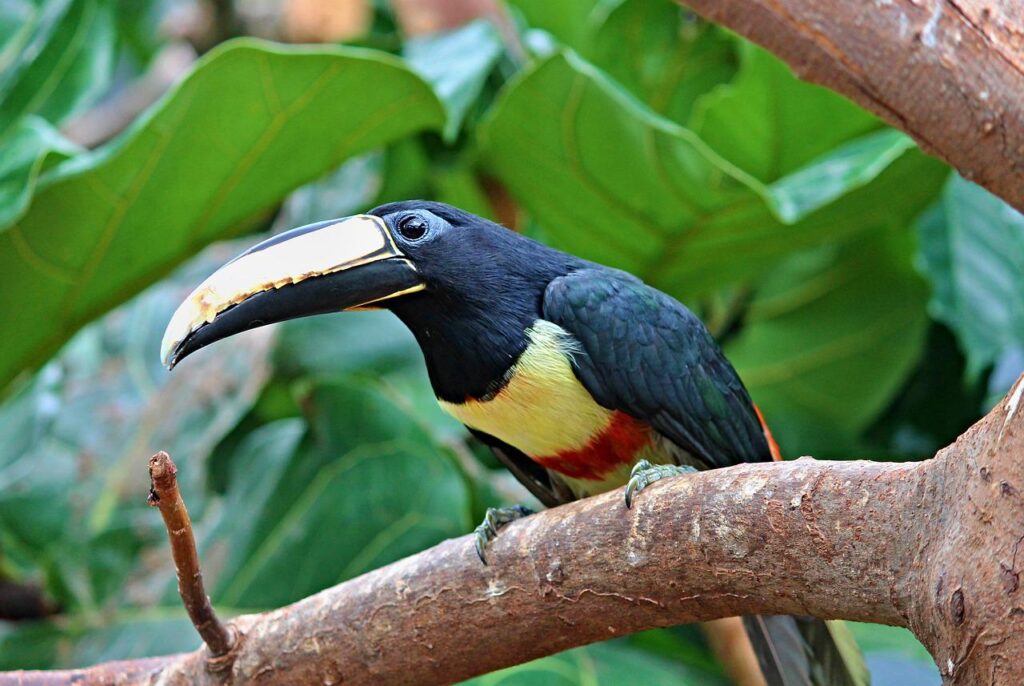
Collared aracari looks like a calm toucan and is remotely equated with a toco toucan. The birds are native to Central America, from southern Mexico to northern Colombia, the regions where most toucanet species are usually found. Their bodies are composed of a variety of vibrant tones that resemble a rainbow of red, green, and yellow spikes. They have red and blue feathers surrounding their eyes. The birds are so adorable, and they are usually found running around. Young collared aracaris are taken care of not only by their parents but also by a group of grown-up birds.
The birds feed on small vertebrates, palm trees, and large insect fruits. They have long beaks of 4 inches long.
9. Kiwi
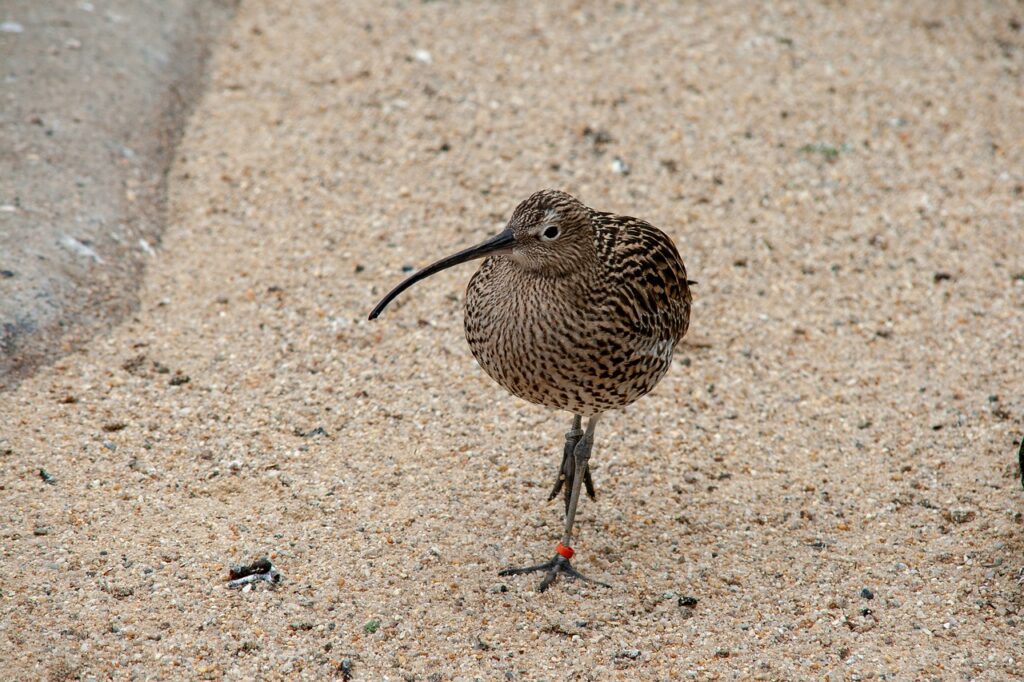
Kiwis are originally found in New Zealand’s jungles and forests. The bird is also a national symbol of the country. Kiwis cannot fly, and they are almost wingless. Despite its small size, a kiwi can run faster than a human.
Kiwi has a very good memory. They have memories of five years back before. Kiwi’s feathers look like fine hair, but the feathers are useful for them to camouflage when there’s a predator.
Kiwis are very thick, and they have bones containing marrow, making them difficult to perch on trees. To settle in, Kiwis dig tunnels instead of building a house and change the feathers into bristles around the base of the beak.
A kiwi can have a long last relationship with a partner for up to 20 years. It has a special beak of 3.5 to 4.7 in length.
10. Woodpecker
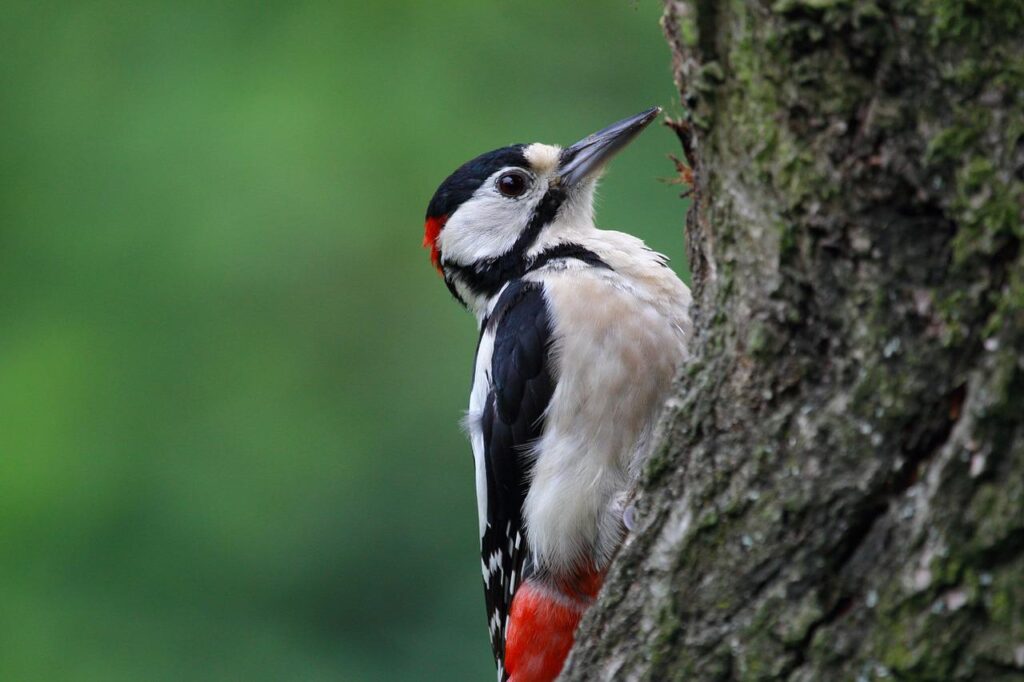
You can find woodpeckers all around the world except in Australia, New Zealand, New Guinea, Madagascar, and the extreme polar regions. Woodpeckers mostly eat seeds, fruits, berries, pine seeds, sap, insects, and acorns.
Woodpeckers have four colors: red, white, yellow, and black. They have long tongues that can be used to capture their prey. They have a beak that has the shape of a chisel, and they use their beaks to drill holes in trees when they are looking for food or to make nests.
These birds can peck up to 20 times in a second. They have feathers on their nostrils to protect them from inhaling the wood particles. Another fact about woodpeckers is that they only have one mate in their lives. The females lay 2 to 4 eggs in a lifetime.
11. Shoebill
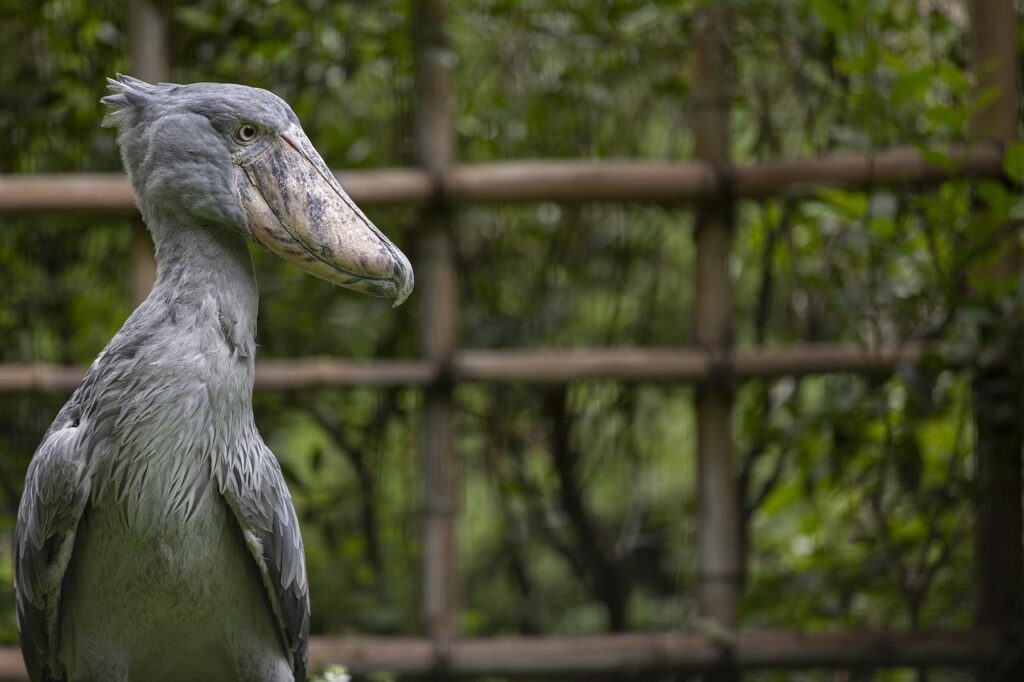
The beak length of the shoebill is 7.4 to 9.4 inches. It has a huge shoe-shaped beak. They live in large swamps of tropical East Africa. Their beaks have sharp edges to help them kill their repulsive prey and cut plants that are on their way. The beak also has a snappy snare at the top that allows them to hold, crush, and pierce their prey at the same time. These birds are as extreme as they look.
Shoebill is known for its calmness and its ability to stay still for a long time. They feed on monitor lizards, snakes, big fishes, and small crocodiles.
Shoebill has gray feathers and large feet. They interact with each other only for breeding purposes. Otherwise, they tend to live alone. Shoebill was initially identified as storks, although it was then found that they are of a different kind. But they do have similar characteristics to storks and herons: they have long necks and their legs typical of swimming-flying animals.
However, this bird’s closest relative is the pelican. Shoebill is a family of birds of their own, although they were once identified as storks. They do share some characteristics with storks and herons, such as long necks and the shape of their legs that are of swimming-flying creatures. But their nearest relatives are the pelicans.
12. Great hornbill
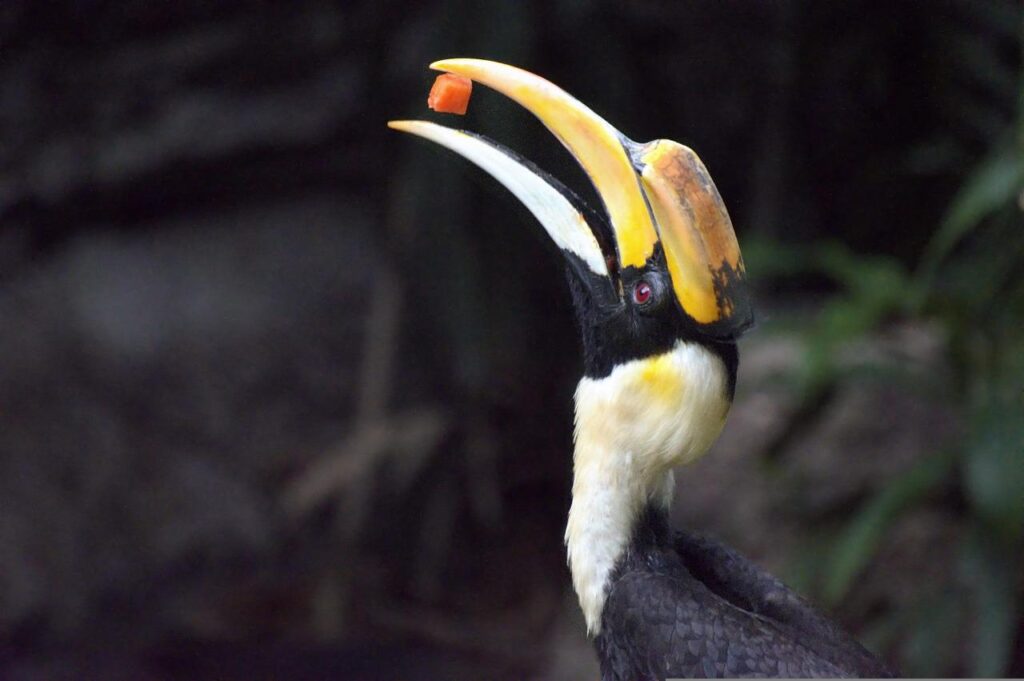
The great hornbill is originally from Indonesia, Malaysian Peninsula, and mainland Southeast Asia. They usually live in moist and tall evergreen forests that are densely populated with old trees that are perfect for nesting. The bird has a bright yellow and black casque on the top of its huge beak. Although it seems like the bird doesn’t need it, the casque might be used for mating purposes. The male birds are sometimes seen head-butting each other using their casques when they fly.
For mating purposes, the males use the casque to fight other males so that they can attract female birds. It takes about five years for the cask to develop prominently. There is a black band on the bird’s tail. Female birds have a white iris, while male birds have a red iris. The birds eat small animals, insects, and fruits. The first two neck vertebrae of these birds were intertwined to support the giant beak. The beak looks very heavy, but it’s actually very light because it consists of thin-walled empty cells. The largest hornbill can be found in the Indian subcontinent. It is said that the great hornbill’s wing beat can be heard from far away!
The biggest hornbill can eat as much as 150 figs at one time.
13. Black skimmer
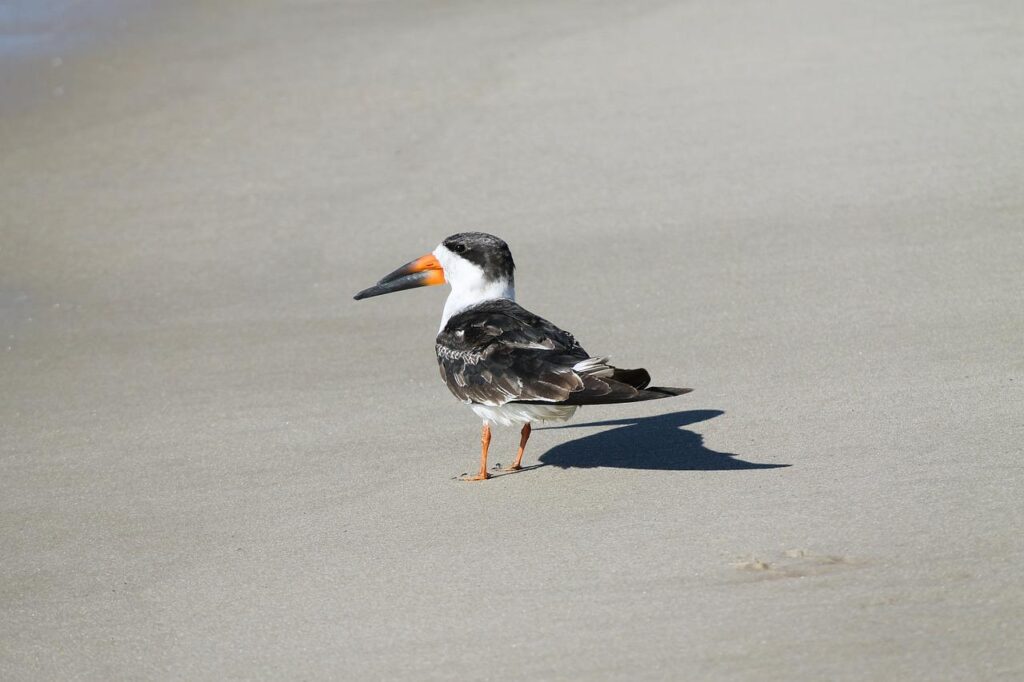
Black skimmers are identified as the seabird species, and they are found along the coast of North America. The beak is 3 to 4 inches long and is very sharp, with the lower half protruding towards the upper half. They also have striking red feet that resemble their bright red-orange beaks.
Black simmers have black feathers on their heads and backs. During the breeding season, the grown-up birds will have a black-colored crown, nape, and upper body. The birds breed in groups, and the females usually lay 3 to 7 eggs on sandy beaches. The eggs are incubated by both the male and female. They usually eat fish, crustaceans, and shrimps.
When the bird flies, it soaks its lower beak into the water and looks for fish. The razor-sharp beak cuts through the water and snaps the upper beak when it finds a fish. This bird is one of a kind that uses this technique to get a fish in North and South America. When it flies, it soaks its lower jaw in water and looks for fish. A razor-sharp beak can cut through the water and snap the upper jaw if you find a fish. Skimmers are the only larval species in the Americas with such foraging techniques.
14. Australian pelican
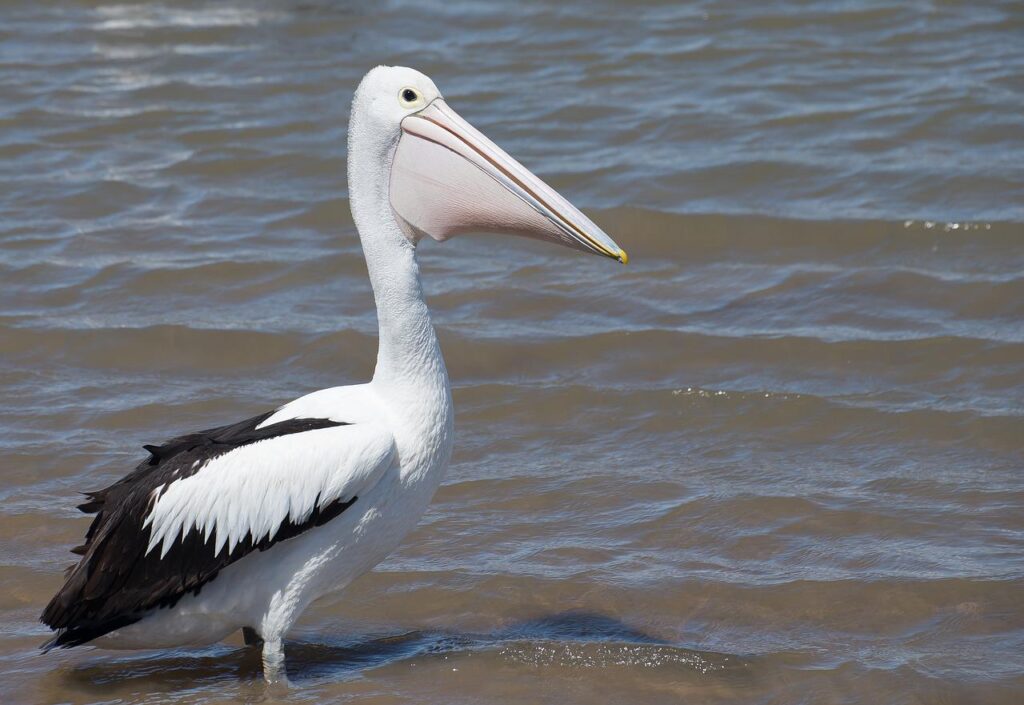
The Australian pelican is found along the Australian coast and inland New Guinea and Fiji. They are also found in New Zealand and Indonesia. The length of the beak is 15 to 17 inches. They have the longest beak among living birds. They eat fish, but they also prey on smaller birds.
The beak is a distinctive pink color with white stripes and black-tipped wings. Australian pelicans live in vast waters with few aquatic plants. They have very large wings. Despite its huge size, the Australian pelican can fly effectively.
These birds breed at any time of the year. They make their nest out of twigs, grass, and quills.
Male pelicans perform a pursuing dance in an attempt to attract females. If the females are attracted, they will go to their nests and will lay 1 to 3 eggs in the nest.
Small pelicans are not able to see, and they don’t have feathers. The young pelicans leave their nests after a month. The grown-ups will still watch over them until the birds are able to fly.
15. Roseate spoonbill
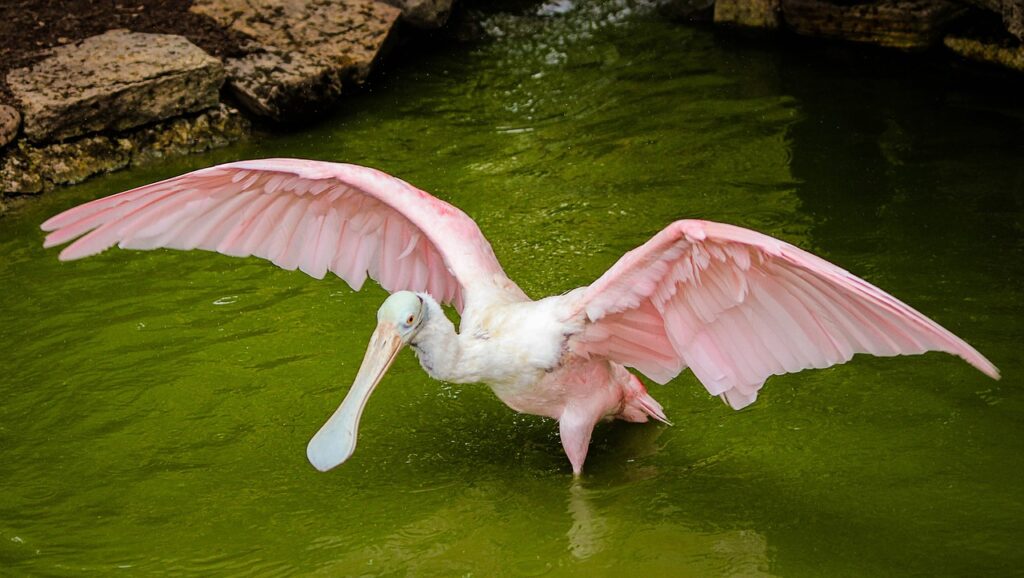
Based on its name, the bird has a beak that resembles a spoon. Roseate spoonbill has very long and flattened beaks. They are mostly found in the Caribbean, Central America, and Mexico. Its 9.4 inches long beak is useful for getting their food, such as crabs, fish, shrimps, lugs, crayfish, and molluscs. The spoon-shaped beak is the most special characteristic of this bird. The bird has a white head and chest. It has a pink-colored body and very long pink legs. Its long legs are useful when it walks on water.
These birds live in trees and shrubs along the edges of the waters. The male and female birds build their nest together, and they both incubate eggs. The 2 to 4 eggs are laid by the females.
Spoonbill hunts its food in shallow waters by strolling around and moving its beak. The bird uses its nose to get small creatures from water, such as small fish, small amphibians, and scavengers.
Conclusion
In summary, birds with long beaks are much more than the ones we mentioned above. However, keep in mind that every beak works differently for every bird. Some beaks are used to tear the prey, some are used to catch fish in the water, and some are used to intimidate other species. These beaks help birds in many ways.
They use the beaks to feed and, in some cases, use them to regulate the body temperature of birds. The above list is useful for bird lovers and those who enjoy studying birds, but there are still many other long beak birds with long beaks that are not on our list.


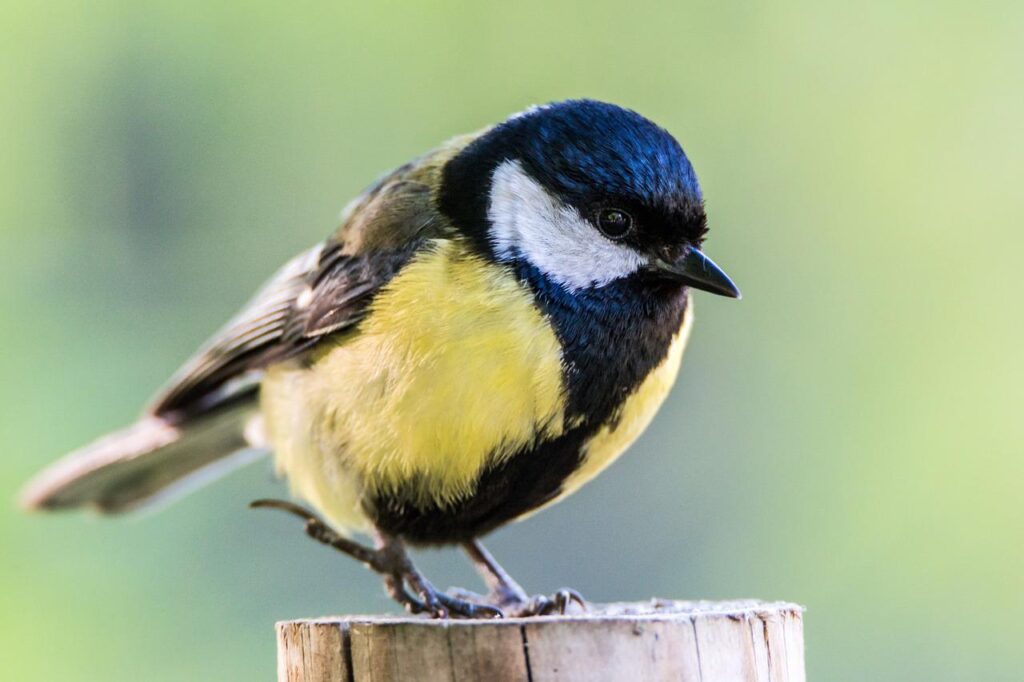


Leave a Reply
You must be logged in to post a comment.